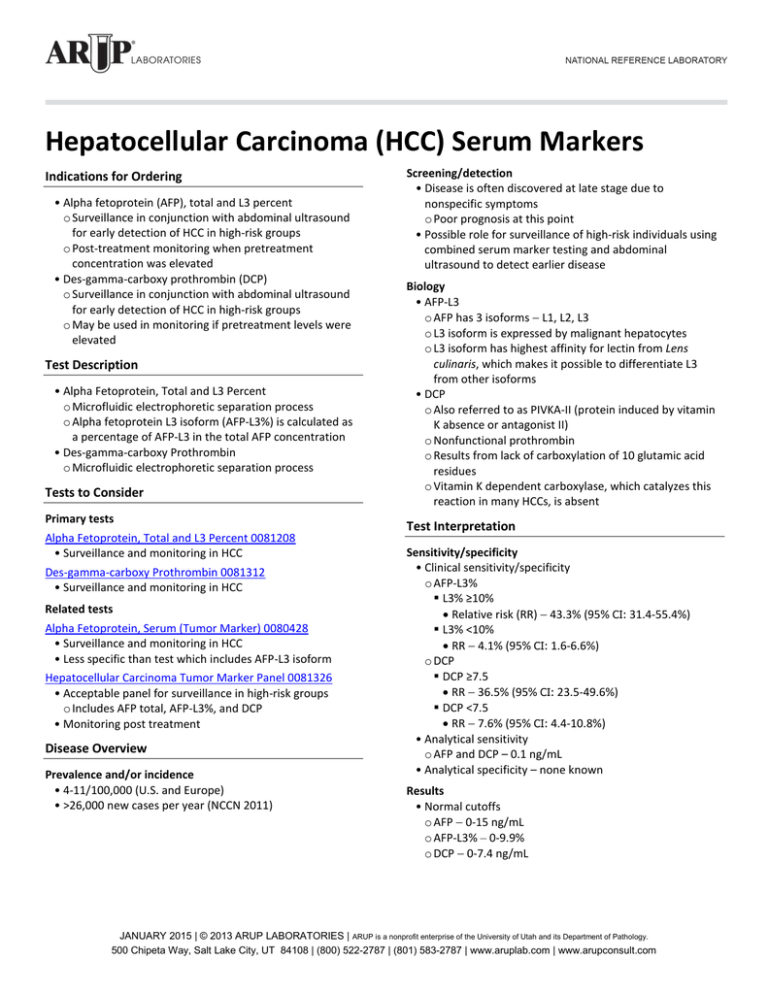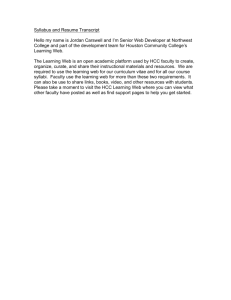Hepatocellular Carcinoma (HCC) Serum Markers
advertisement

Hepatocellular Carcinoma (HCC) Serum Markers Indications for Ordering • Alpha fetoprotein (AFP), total and L3 percent o Surveillance in conjunction with abdominal ultrasound for early detection of HCC in high-risk groups o Post-treatment monitoring when pretreatment concentration was elevated • Des-gamma-carboxy prothrombin (DCP) o Surveillance in conjunction with abdominal ultrasound for early detection of HCC in high-risk groups o May be used in monitoring if pretreatment levels were elevated Test Description • Alpha Fetoprotein, Total and L3 Percent o Microfluidic electrophoretic separation process o Alpha fetoprotein L3 isoform (AFP-L3%) is calculated as a percentage of AFP-L3 in the total AFP concentration • Des-gamma-carboxy Prothrombin o Microfluidic electrophoretic separation process Tests to Consider Primary tests Alpha Fetoprotein, Total and L3 Percent 0081208 • Surveillance and monitoring in HCC Des-gamma-carboxy Prothrombin 0081312 • Surveillance and monitoring in HCC Related tests Alpha Fetoprotein, Serum (Tumor Marker) 0080428 • Surveillance and monitoring in HCC • Less specific than test which includes AFP-L3 isoform Hepatocellular Carcinoma Tumor Marker Panel 0081326 • Acceptable panel for surveillance in high-risk groups o Includes AFP total, AFP-L3%, and DCP • Monitoring post treatment Disease Overview Prevalence and/or incidence • 4-11/100,000 (U.S. and Europe) • >26,000 new cases per year (NCCN 2011) Screening/detection • Disease is often discovered at late stage due to nonspecific symptoms o Poor prognosis at this point • Possible role for surveillance of high-risk individuals using combined serum marker testing and abdominal ultrasound to detect earlier disease Biology • AFP-L3 o AFP has 3 isoforms − L1, L2, L3 o L3 isoform is expressed by malignant hepatocytes o L3 isoform has highest affinity for lectin from Lens culinaris, which makes it possible to differentiate L3 from other isoforms • DCP o Also referred to as PIVKA-II (protein induced by vitamin K absence or antagonist II) o Nonfunctional prothrombin o Results from lack of carboxylation of 10 glutamic acid residues o Vitamin K dependent carboxylase, which catalyzes this reaction in many HCCs, is absent Test Interpretation Sensitivity/specificity • Clinical sensitivity/specificity o AFP-L3% L3% ≥10% • Relative risk (RR) − 43.3% (95% CI: 31.4-55.4%) L3% <10% • RR − 4.1% (95% CI: 1.6-6.6%) o DCP DCP ≥7.5 • RR − 36.5% (95% CI: 23.5-49.6%) DCP <7.5 • RR − 7.6% (95% CI: 4.4-10.8%) • Analytical sensitivity o AFP and DCP – 0.1 ng/mL • Analytical specificity – none known Results • Normal cutoffs o AFP − 0-15 ng/mL o AFP-L3% – 0-9.9% o DCP − 0-7.4 ng/mL JANUARY 2015 | © 2013 ARUP LABORATORIES | ARUP is a nonprofit enterprise of the University of Utah and its Department of Pathology. 500 Chipeta Way, Salt Lake City, UT 84108 | (800) 522-2787 | (801) 583-2787 | www.aruplab.com | www.arupconsult.com Limitations • Not all HCCs secrete AFP and/or DCP o Test is not useful for monitoring if pretreatment levels were not elevated • False-positive result may occur in the following clinical contexts o AFP-L3% Pregnancy Age <1 year Acute fulminant hepatitis Cirrhosis o DCP Obstructive jaundice Intrahepatic cholestasis Drugs (eg, warfarin) JANUARY 2015 | © 2013 ARUP LABORATORIES

